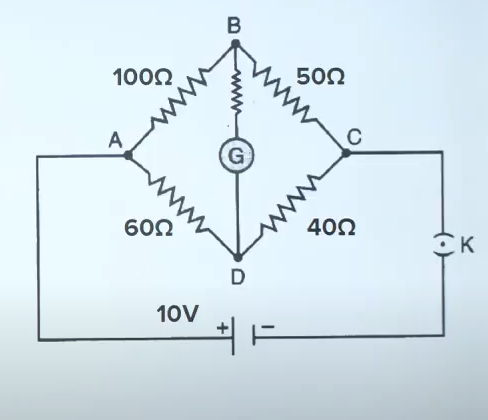A current of 400μA can deflect the coil of galvanometer by 40. Calculate the amount of current required to rotate the coil through 60. Also find the current sensitivity of the galvanometer.
To solve the problem, we will follow these steps:
Step 1: Identify the given data
- Current (I) = 400 µA (microamperes)
- Deflection (θ) = 40 degrees
- Required deflection (θ') = 60 degrees
Step 2: Calculate the current per degree of deflection
We need to find the current required for each degree of deflection. This can be calculated using the formula:
Ig=Iθ
Substituting the values:
Ig=400μA40degrees=10μA/degree
Step 3: Calculate the current required for the new deflection
Now, we need to find the current required to achieve a deflection of 60 degrees. We can use the current per degree of deflection calculated in Step 2:
I′=Ig×θ′
Substituting the values:
I′=10μA/degree×60degrees=600μA
Step 4: Calculate the current sensitivity of the galvanometer
Current sensitivity (S) is defined as the deflection per unit current. We can express it as:
S=1Ig
Substituting the value of Ig:
S=110μA/degree=105degrees/A
Final Answers
- The amount of current required to rotate the coil through 60 degrees is 600 µA.
- The current sensitivity of the galvanometer is 10^5 degrees/A.
---
- Current (I) = 400 µA (microamperes)
- Deflection (θ) = 40 degrees
- Required deflection (θ') = 60 degrees
We need to find the current required for each degree of deflection. This can be calculated using the formula:
Now, we need to find the current required to achieve a deflection of 60 degrees. We can use the current per degree of deflection calculated in Step 2:
Current sensitivity (S) is defined as the deflection per unit current. We can express it as:
- The amount of current required to rotate the coil through 60 degrees is 600 µA.
- The current sensitivity of the galvanometer is 10^5 degrees/A.
Topper's Solved these Questions
- BOOK - MODERN PUBLICATIONCHAPTER - MOVING CHARGES AND MAGNETISMEXERCISE - COMPETITION FILE (A. MULTIPLE CHOICE QUESTIONS)38videos
MOVING CHARGES AND MAGNETISM
- BOOK - MODERN PUBLICATIONCHAPTER - MOVING CHARGES AND MAGNETISMEXERCISE - COMPETITION FILE (B. MULTIPLE CHOICE QUESTIONS)79videos
MOVING CHARGES AND MAGNETISM
- BOOK - MODERN PUBLICATIONCHAPTER - MOVING CHARGES AND MAGNETISMEXERCISE - Revision Exercises (Long Answer Questions )12videos
MOVING CHARGES AND MAGNETISM
- BOOK - MODERN PUBLICATIONCHAPTER - MAGNETISM AND MATTEREXERCISE - CHAPTER PRACTICE TEST FOR BOARD EXAMINATION16videos
MAGNETISM AND MATTER
- BOOK - MODERN PUBLICATIONCHAPTER - NUCLEIEXERCISE - CHAPTER PRACTICE TEST FOR BOARD EXAMINATION15videos
NUCLEI
Similar Questions
Define the current sensitivity of a galvanometer. Write its SI unit.
View SolutionA current of 300μA deflects a coil of a moving coil galvanometer through 30∘. What should be the current to cause the rotation through π/5 radius? What is the current sensitivity of the galvanometer ? If resistance of galvanometer is 50Ω, find its voltage sensitivity.
View Solution
Knowledge Check
- Question 1 - Select One
Current sensitivity of a galvanometer is given by
ACθ/nBABnBA/CCnBA/CGDCG/nBA - Question 2 - Select One
In order to increase the current sensitivity of a moving coil galvanometer the
Anumber of turns of the coil should be increase.Bstrength of the magnetic field should be increasedCarea of the coil should be increasedDall of the above - Question 3 - Select One
The current sensitivity of a moving coil galvanometer depends on
Athe number of turns in the coilBmoment of inertia of the coilCstrength of the magnetic fieldD(a) and (c) both
A current of 500μA deflects the coil of a moving coil galvanometer through 60∘. What should be the current to cause the rotation through π/5 radian? What is the sensitivity of galvanometer?
View SolutionA current of 300μA deflects the coil of a moving coil galvanometer through 60∘. What should be the current to cause rotation through π/5rad? Determine the sensivity of this galvanometer.
View SolutionDefine the term 'current sensitivity' of a moving coil galvanometer.
View SolutionWhen a current of 100μA is passed through the coil of a moving coil galvanometer, it is deflected through an angle of 15∘. Calculate the value of current required to cause a deflection of π/20 radians. Also, calculate the sensitivity of the galvanometer.
View SolutionFind current through galvanometer
 View Solution
View Solution

